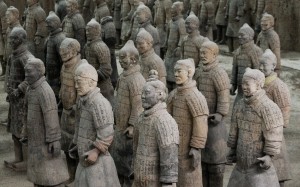
Terracotta Army refers to the collection of terracotta sculptures that depicts the armies of first male ruler of China, Qin Shi Huang. It is a kind of funerary art buried with the ruler in 210-209 BC. Mythology suggests that it was done so as to protect the ruler in his life after death.
It was first discovered in 1974 by some rural farmers in Shaanxi province. The figures that appear in the sculptures have different heights, with the tallest depicting the generals and shortest depicting the army’s starting rank.
Along with human figures like warriors & horses, it also included sculptures of chariots & weapons used. There were other non-military figures also like those of musicians, acrobats, officials and strongmen. There are 3 pits found having these sculptures.
Estimates suggest that it contains over 8000 soldiers, 130 chariots with 520 horses and 150 cavalry horses.
Historical Background
The Terracotta army was first discovered on 29th March 1974 by a group of farmers in east of Xi’an in Shaanxi province. While digging a water well of around 1.6 km east of Qin Emperor’s tomb mound at Mount Lishan, they found pieces of Terracotta figures and fragments such as bricks, slab of fired clay used in roofing and chunks of masonry.
These findings encouraged archaeologists to investigate and they discovered one of the biggest figurine group.
Along-with sculptures of warriors, an entire man-made necropolis for the ruler has also been found around his tomb mound. It consists of offices, halls and other structures that are being surrounded by two solid rammed earth walls with gateway entrances. While digging around Mount Li burial mound, archaeologists found many graves that dated from eighteenth to nineteenth centuries.
Recent scientific works at the site also found high levels of mercury in the soil of tomb mound. The tomb of Shi Huangdi appeared to be a hermetically sealed space with size similar to a football pitch and located underneath the pyramidal tomb mound. Historical facts suggest that after the death of Emperor, his tomb had been looted by Xiang Yu, a contender for the throne.
Only a section of the site has been recovered through digging. It is also open only to selected foreign dignitaries to walk through the pits and observe the sculptures closely.
– See more at: https://lifestyletango.com/terracottawarriorexhibit/terra-cotta-army/#sthash.Fiwdndud.dpuf